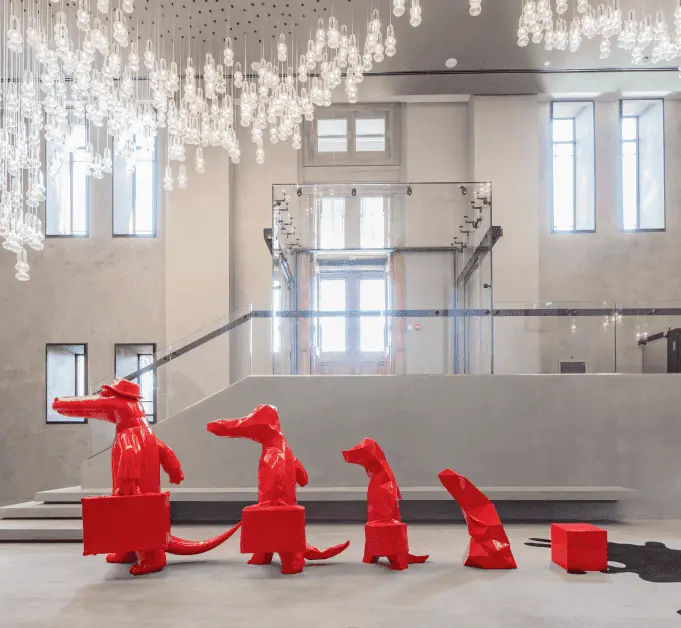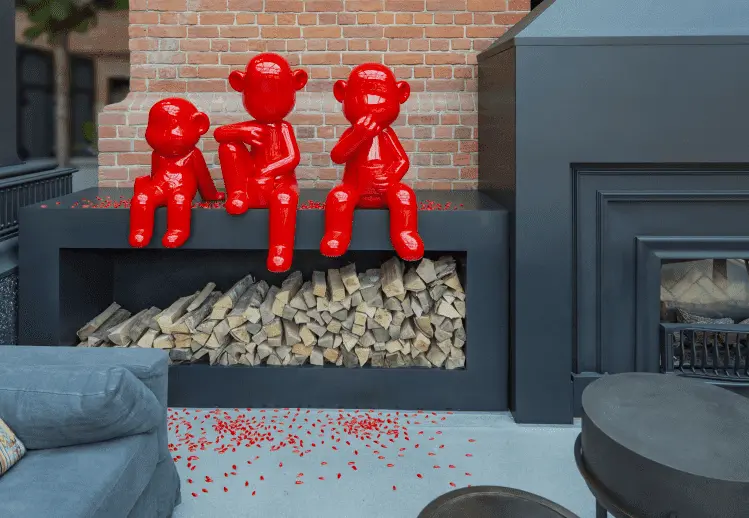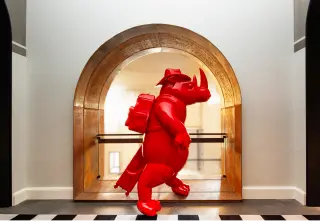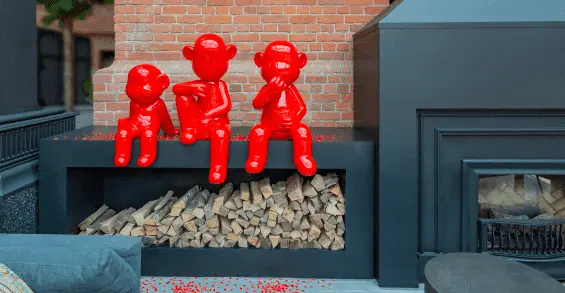From history to modernity
The building where the hotel is located was built in 1910 with donations from the famous grain tradesman, Kazan merchant of the first guild Yakov Shamov, and for a long time bore his name. The architect K. Oleshkevich, according to whose project the building was erected, perpetuated the name of the founding merchant by creating the building in the shape of the Russian letter «Ш». Today the building is an object of the cultural heritage of republican significance. During the restoration process, the space between the verticals of the letter «Ш» was connected by a glass roof, so a spacious and bright atrium appeared, where an abundance of living plants is intertwined with fanciful bright sculptures by Turkish cartoonist Erdil Yaşaroglu. Here is a cozy Kazanda Atrium Lounge restaurant. The historical walls, which were outside, turned out to be inside after restoration and now create a flavor of antiquity surrounded by the modern atmosphere of the restaurant, greenery, and a real fireplace.
The architects of the hotel carefully approached the preservation of the historical heritage of the building, leaving its appearance for future generations. Many elements of the interior have been transformed: the main marble staircase has been restored, which became the dominant feature of the hotel's entrance group, today it is a stylish decorative element, each time reminiscent of a rich historical past.
The hotel museum
Kazan, with its thousand-year history, is a place where East and West meet. The gallery connecting the buildings of two TASIGO hotels - the historic Kazan Palace and the modern NEO Kazan Palace - houses the Museum named after Yakov Shamov, a Kazan merchant of the first guild, philanthropist, and founder of the first large city hospital in Kazan, which was opened in 1910.
The museum contains cases of the everyday life of Kazan doctors, which were recorded during the examination of new devices, emotions during medical consultations, and important professional and valuable events of people who worked in observations at a significant place in the city. You can plunge into the medical agenda of that time by studying fragments of work correspondence neatly placed on the walls, look at the team’s award and get to know the outstanding hereditary Shamov family, so far from medicine, but which has become so rare for individual cities and many of its patients. The Museum of the Kazan Palace has become the memory and cultural heritage of an amazing place, open to everyone interested in going to an extraordinary historical landmark, that was a witness of many human destinies.

The patronage goes on
And just like at the beginning of the twenty century the building was founded at the expense of the merchant and philanthropist Yakov Shamov, 100 years later Erol Tabanca - architect and owner of the Polimeks company was engaged in its renovation. Having provided many years of support to contemporary artists, contributing to the development of education, and creating museum, Erol Tabanca could not give up the idea of renovating a cultural heritage object after seeing a historical building in Kazan. Implemented architectural solutions during the reconstruction he continued to create an atmosphere of interiors. Polimeks designers used his graphic sketches made during meetings, turning them into paintings and large-scale metal art objects. By walking through the halls of hotels our guests explore them and get to know the author better.
In Polimeks art is considered a source of knowledge and energy especially when there is an option to keep rich historical traditions for future generations. Erol Tabanca has this desire to provoke an artistic regeneration. Being a truly modern art connoisseur and one of the leading collectors Erol Tabanca founded OMM - Odunpazarı Modern Museum in Turkey, that received the "International Project of the Year" award. Tabanca is sharing with us the roots of his passion for art and shows it in each project Polimeks takes. Here is a brilliant example of progressive art connection – from a form of an amateur’s admiration to a marvelous collection of art pieces exhibited in the museum and renovated historical buildings in different countries.
The historical transformation
The architects of the Polimeks company focused on restoring the historical facade of the building, trying to preserve the style features of the Art Nouveau era. The symbol of the reconstruction was a structure made of steel and glass, resulting from the connection of the space between the vertical walls, built in the shape of the letter Russian letter "Ш". By connecting them with a glass roof, we got a large space of the bright atrium.
The TASIGO logo
The hotel logo is drawn with smooth lines covering the arches that can be seen in the architectural building. Eight arcs of the logo, intertwined, an unusual external ornament resembling an eight-pointed star, is an important symbol in the history of the Turkic peoples, in particular the Seljuks. The star marks balance and harmony, and each of its ends symbolizes virtue, without which nations cannot imagine their development. The juxtaposition of the eight-pointed star and the arches used in hotel architecture speaks of an incredible fusion of history and modern culture. The binding of antiquity and modernity is made by designers in the general appearance of the building and in a close composition. The two different colors of the logo have a broad meaning, the exceptional features of Tatarstan, where for many centuries people of different cultures and religions live peacefully on the same territory, manifest themselves with awe and respect for a friend and this hospitable land.
Art objects
When you get to the lobby of Kazan Palace by TASIGO , admiration and a smile will not leave your face, because the first thing that greets guests in the spacious lobby of the hotel is the sculptural composition of the traveler crocodile (The traveler), made according to the sketches of a fashionable and original Turkish artist - caricaturist Erdil Yasaroglu, participant of international exhibitions in the field of architecture and design. In his works, Erdil explores the background of humor, methods of thinking and alternative views on life.
The figure of a large crocodile appears in front of visitor, having gone through all forms of evolution - from a bright red plastic cube to a well-coordinated striving traveler, in whose paw an old-school suitcase is firmly held. This crocodile tells us that traveling helps us to grow and develop, perceiving the world more subtle and more conscious.

The traveler
Sculptures in the hotel
Other residents are located in different areas of the hotel - bears climbing the wall (The beanies), the highest sculpture - the little prince sitting on suitcases (The Prince of Suitcases), as well as figures of surprised children by the fireplace (Kids eating sunflower seeds).
The theme of travel continues to accompany the guests of the hotel, a formidable figure of a rhinoceros is encountered in the hall of the second floor, but noticing the same stylish red suitcase in its bulky paws, alertness is replaced by a gentle smile, caused by the fantasy and humor that Erdil puts into his work.

Kids eating sunflower seeds
In the Kazanda restaurant, a hungry wolf cub (Hungry like a wolf) unequivocally hints at a delicious dinner, and next to the Palace bar, a happy singing bear (Singing in the rain) perched up and does not pay attention to those around. On the street, at the glass passage, there is another bear waiting for the rain (Rain), looking at which one really wants to run into the warm and cozy space of the hotel.
The author, fashionable cartoonist Erdil Yasharoglu, created all his works especially for Kazan Palace by TASIGO . This fact once again reminds us that TASIGO hotels are a place of attraction for art lovers.

The beanies

Singing in the rain

Rhinoceros

Rain

The prince of suitcases

Hungry like a wolf
Pictures by Roman Peeks
Roman Peeks, an artist and illustrator from Moscow, began his career in the early 2000s. The main source of ideas for the artist is the urban environment, focused on resources - a variety of techniques: from monumental art to embroidery and collage. The works are designed in an expressive-primitivist manner, where characters and motives are intertwined, forming three-dimensional ornaments. The meaning of the works is always ironic: the prevalence of statements turns into a different degree of their interpretation. In his embroidery, the artist also lays the possibility of tactile communication - one of the sides of attention. Since 2007, he has been participating in street art festivals, group exhibitions, collaborating with well-known brands - Jameson, Jack Daniels, Adidas, Nike and others. Participant of the Biennale of street wave art ARTMOSSPHERE in Moscow (2018). Pieces are held in the collections in Russia, France, Germany and Italy.
Graffiti artist and illustrator. The creator of completely unique images born from his own fantasies. Thoughtful imaginary ornaments intertwined into a bright masterpiece for our special room for people with disabilities.

.png)




















